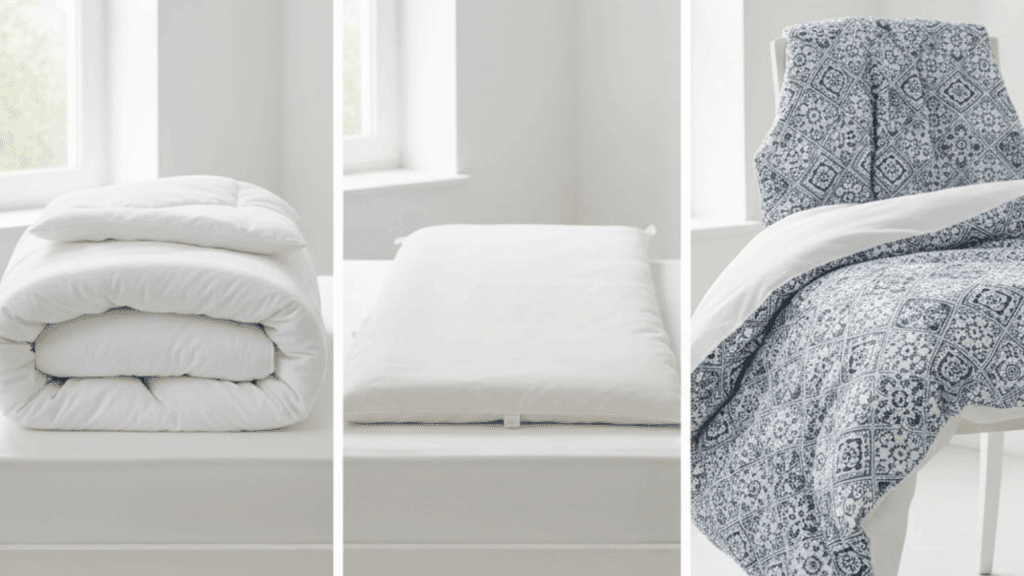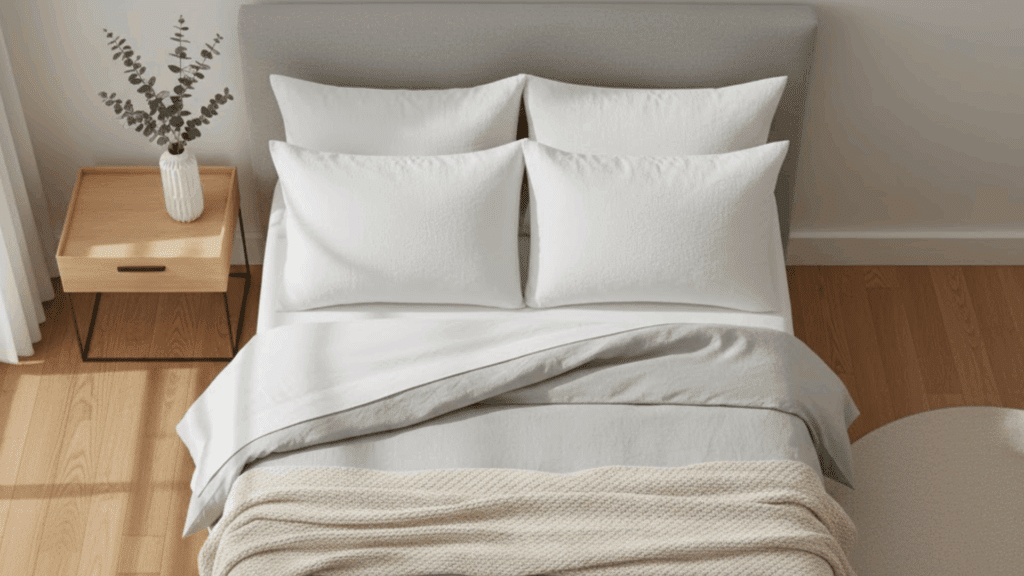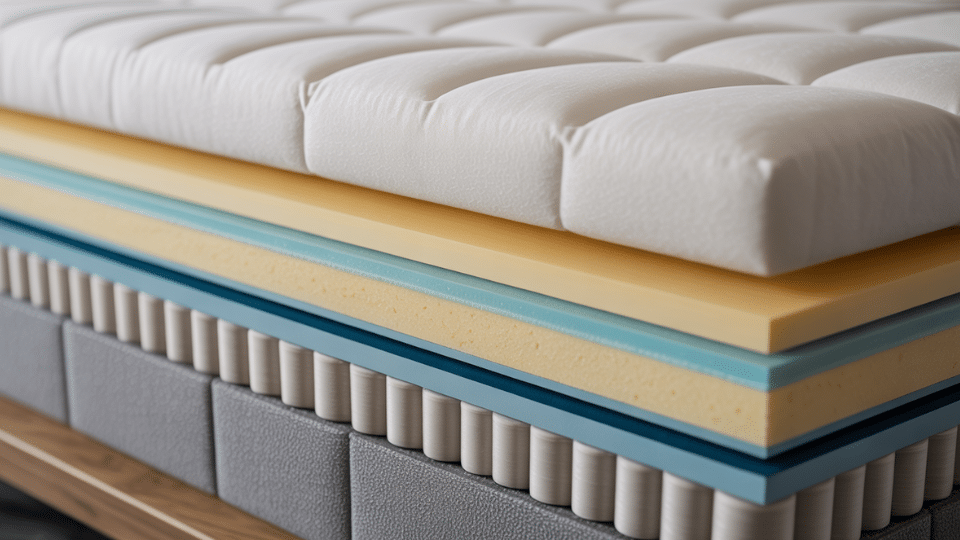If you’ve ever looked at your bed and wondered, “Can I put my comforter inside a duvet cover?”, you’re not alone. I’ve asked the same thing, and the good news is: yes, you totally can!
In this blog, I’ll walk you through everything you need to know in the simplest way possible.
We’ll talk about why people like using a duvet cover with a comforter, how to match the right sizes, and an easy step-by-step method to get the comforter inside without a fight.
I’ll also explain how to keep everything in place, the difference between comforters and duvets, and how to care for both. By the end, you’ll know exactly how to set up your bed the easy way.
Is it Okay to Put a Comforter in a Duvet Cover?
Let’s get straight to the point: yes, you absolutely can put a comforter in a duvet cover! In fact, it’s one of the most popular bedding setups around.
Duvet covers aren’t just for duvets. They work perfectly with regular comforters, too. A duvet cover is like a giant pillowcase for your bed. Just like you slide a pillow into a pillowcase, you can slide a comforter into a duvet cover.
Why so Many People Do This:
The protection factor is huge. Your comforter stays clean and protected from everyday life—spills, dirt, pet fur, you name it. Instead of washing your heavy comforter all the time, you just wash the lightweight cover.
It’s also a style game-changer. Want to switch from bright summer colors to cozy fall vibes? Just change the duvet cover. No need to buy a whole new comforter. You can have five different looks with just one comforter and a few covers.
Plus, it makes your comforter last way longer. When it’s not exposed to constant washing and daily wear, it keeps its fluffiness and warmth for years.
The best part? There’s a super-easy trick to get your comforter inside the cover without fighting with it. Let’s check it out.
Guide to Put a Comforter Inside a Duvet Cover

Ready to learn the easiest way ever? This method is called the “burrito roll” or “California roll,” and once you try it, you’ll never go back to the old way of struggling with your bedding.
Here’s what to do:
- Turn your duvet cover inside out – Just flip it so the inside is facing you.
- Lay it flat on your bed – Make sure the opening is at the foot of the bed (the bottom part where your feet go).
- Spread your comforter on top – Lay your comforter flat on top of the inside-out duvet cover. Line up all the corners so everything matches up nicely.
- Roll it up like a burrito – Starting from the head of the bed, roll both layers together tightly toward the foot. Keep rolling until you reach the opening.
- Flip the cover over the roll – This is the magic part! Reach into the opening and pull the duvet cover right-side out over each end of the burrito roll.
- Unroll everything – Once the cover is flipped, unroll the whole thing back down the bed. Your comforter should now be inside the cover!
- Close it up and adjust – Button, zip, or tie the opening closed. Give everything a shake and smooth it out so it looks perfect.
This method sounds complicated when you read it, but once you try it one time, you’ll be amazed at how easy it actually is. No more crawling inside the duvet cover or getting tangled up!
Why Using a Duvet Cover Over Your Comforter is a Smart Idea
Wondering why so many people love this setup? There are actually some really good reasons to use a duvet cover with your comforter.
Protection from Everyday Wear and Tear: Your comforter stays safe inside the cover. No worrying about spills, pet hair, makeup stains, or general dirtiness. The cover takes all the hits while your comforter stays fresh.
Way Easier to Wash: Here’s the thing: washing a big, bulky comforter is a pain. It barely fits in the washing machine, takes forever to dry, and you have to do it at a laundromat if it’s too big. But a duvet cover? Super lightweight and easy to toss in the wash. You can wash it as often as you wash your sheets.
Instant Bedroom Makeover: Want to change your room’s look? Just swap out the duvet cover. You can go from floral to solid colors, from light to dark, from summer vibes to cozy winter feels. All without buying a whole new comforter. It’s like having multiple comforters for the price of a few covers.
Makes Your Comforter Last Longer: When your comforter isn’t getting washed constantly or exposed to daily wear, it keeps its fluffiness and shape for years longer. That’s more money saved in the long run.
Will Your Comforter Fit Inside a Duvet Cover?
Size matters when it comes to comforters and duvet covers. You want them to match up pretty closely, or you’ll end up with a lumpy mess or a comforter that slides around like crazy.
Standard Bedding Sizes
| Bed Size | Comforter Dimensions | Duvet Cover Dimensions |
|---|---|---|
| Twin | 66″ × 86″ | 68″ × 88″ |
| Full/Double | 80″ × 86″ | 80″ × 88″ |
| Queen | 88″ × 92″ | 90″ × 92″ |
| King | 104″ × 92″ | 104″ × 92″ |
Your comforter and duvet cover should be within 1-2 inches of each other. A little wiggle room is fine, but too much difference causes problems.
- If the Comforter is Too Small: It’ll bunch up in the corners and shift around inside the cover, leaving empty spots.
- If the Comforter is Too Big: You’ll get lumpy, overstuffed areas that look messy and feel uncomfortable.
Pretty much any type of comforter works inside a duvet cover. Down comforters, down-alternative, synthetic fill, they all fit just fine. The material doesn’t matter as much as getting the size right.
How to Secure Your Comforter Inside a Duvet Cover
Nobody wants to wake up with their comforter bunched up at the bottom of the duvet cover. Here’s how to keep everything in place.
- Use Corner Ties – Most modern duvet covers come with little ties or loops sewn into the inside corners. Your comforter might have matching loops in its corners. Just tie them together, and boom, your comforter stays put.
- Try Duvet Clips – Don’t have built-in ties? No problem! You can buy duvet clips online or at bedding stores. They’re like big safety pins or clamps that attach through the cover and grip the comforter. Super affordable, and they work great.
- The Shake-and-Fluff Method – every few days, give your whole bed a good shake. Hold the duvet cover by the top corners and snap it like you’re making a hotel bed. This redistributes the filling and keeps things even.
Many people set this up once and just leave it. They wash the duvet cover regularly, but keep the comforter inside permanently. When the cover comes out of the dryer, they stuff the comforter right back in. Easy peasy.
Comforter, Duvet, and Duvet Cover: What’s the Difference?

Let’s clear up the confusion because these terms get mixed up all the time.
Comforter
- A quilted blanket with filling sewn inside
- Has stitching patterns that keep the filling in place
- Ready to use straight out of the package
- Usually has a decorative outer layer
- Designed to be used without a cover (but you totally can add one!)
Duvet
- A thick insert that’s meant to be covered
- Usually plain white or cream colored
- Fluffier and puffier than most comforters
- Not designed to be used without a cover
- Common in Europe and becoming more popular everywhere
Duvet Cover
- A removable fabric “sleeve” with an opening on one end
- Protects either a duvet or a comforter
- Comes in endless colors, patterns, and materials
- Easy to wash and change out
In stores, you’ll see people use these words interchangeably. Some companies call everything a “duvet,” even when they mean “comforter.” The main thing to remember is that duvet covers work with both duvets AND comforters.
How to Care for Your Comforter and Duvet Cover
Taking good care of your bedding means it’ll last longer and stay looking great. Here’s how to do it right.
| Duvet Cover Care | Comforter Care |
|---|---|
| Wash every 1–2 weeks | Spot clean when possible |
| Use warm or cold water | Wash seasonally (2–4 times per year) |
| Tumble dry on medium or hang dry | Use a large-capacity washer |
| Iron on low heat if desired | Dry thoroughly to prevent mildew |
| Check the care label instructions | Add dryer balls + air out monthly |
Quick care tips:
- Shake out your bedding when you make the bed each morning
- Use those corner ties or clips to prevent shifting
- Keep pets off the bed if possible (or use a blanket on top for extra protection)
- Store extra duvet covers folded in a cool, dry place
Can You Use a Duvet Cover on Its Own?
Here’s something you might not have thought about: yes, you can use a duvet cover without any insert at all!
During hot summer months or in warm climates, a duvet cover by itself works perfectly as a lightweight blanket. It’s basically just two layers of soft fabric, which is plenty when the weather’s warm.
This works great if you:
- Live somewhere hot
- Love minimalist bedding
- Want something light for summer
- Are between comforters
- Run hot while sleeping
Just use the duvet cover like a regular blanket. You can even fold it at the foot of the bed for a layered look. Some people keep one setup for summer (cover only) and another for winter (cover with a comforter inside).
Final Thoughts
Now that we’ve gone through everything, I hope you feel confident using a duvet cover with your comforter.
I honestly love this setup because it keeps my comforter clean, makes my room look fresh, and saves me so much time on laundry.
With the right size, a few corner ties, and the easy burrito method, putting it all together becomes quick and stress-free.
Plus, knowing the difference between comforters, duvets, and covers makes choosing bedding a lot easier. I like switching up my duvet covers to match the season or my mood, and you can do the same.
If you found this helpful, feel free to ask me for more home tips or bedding advice!









